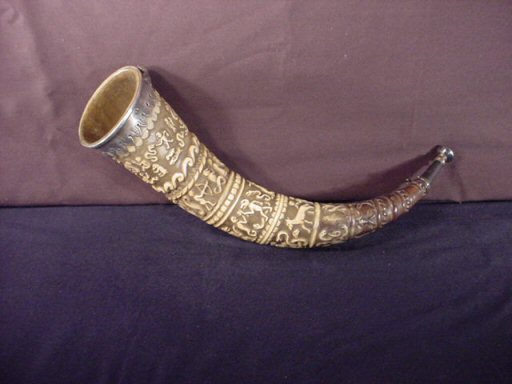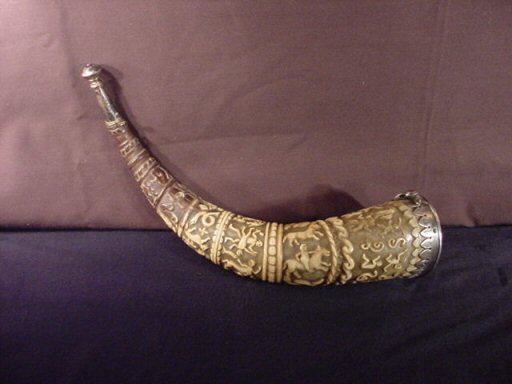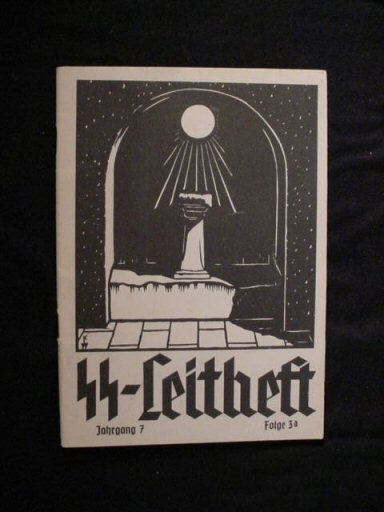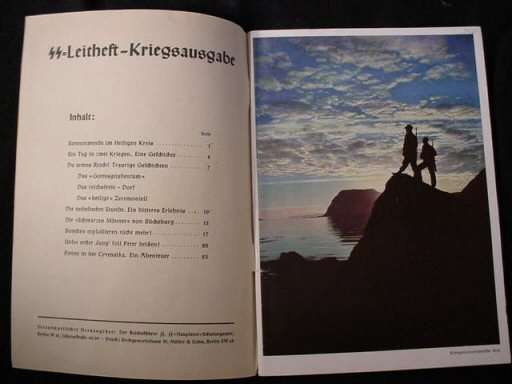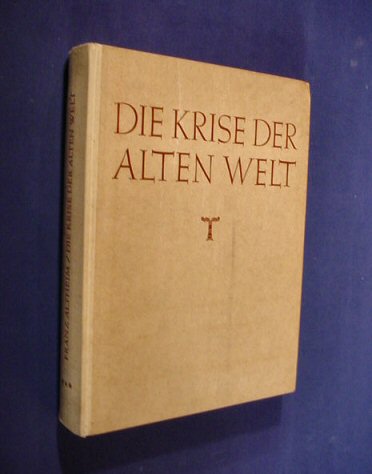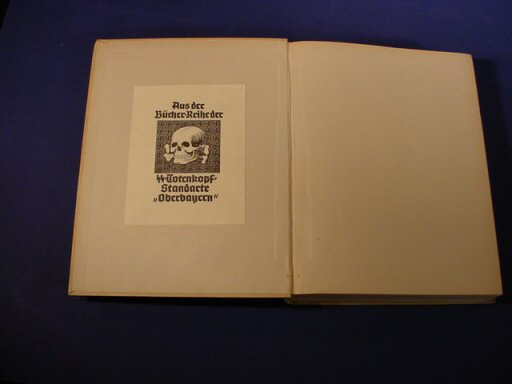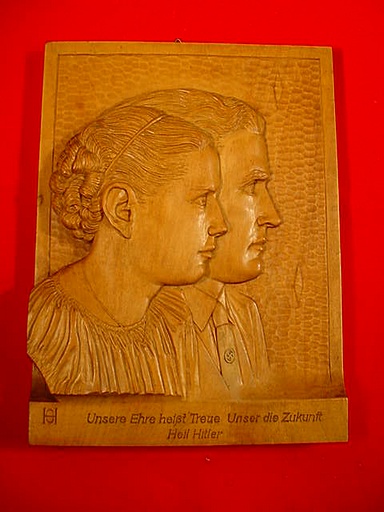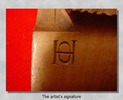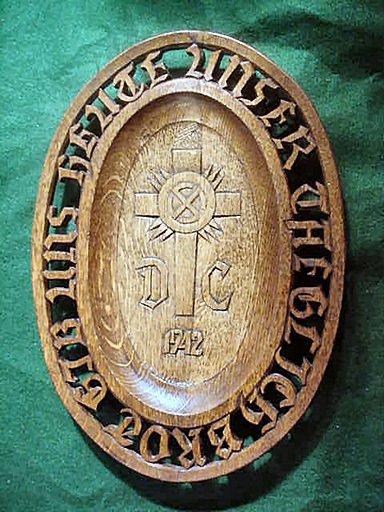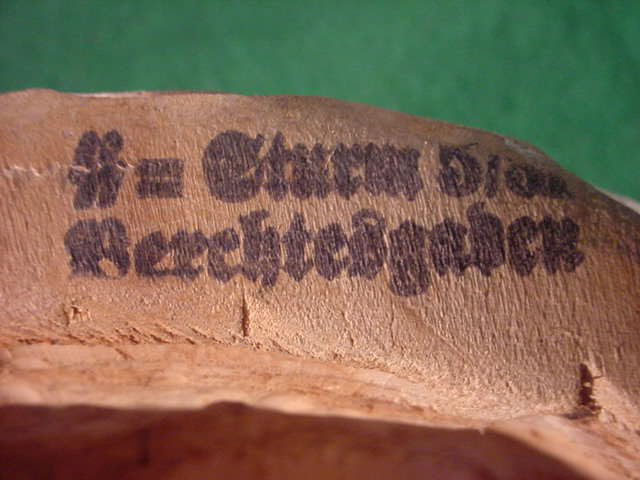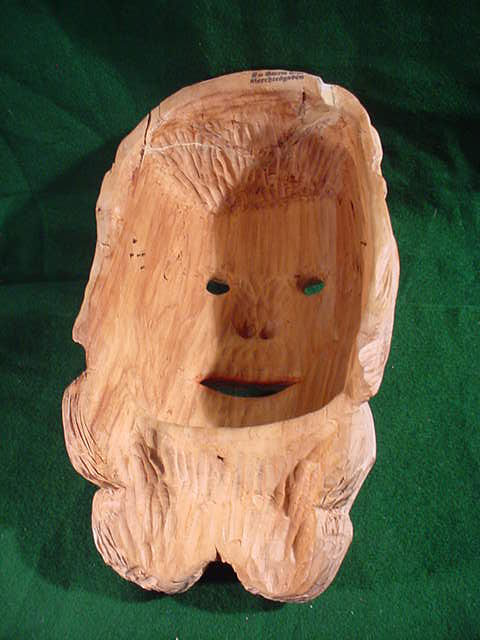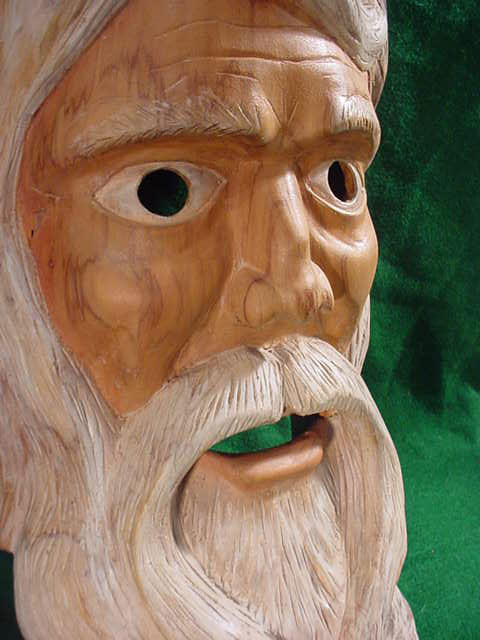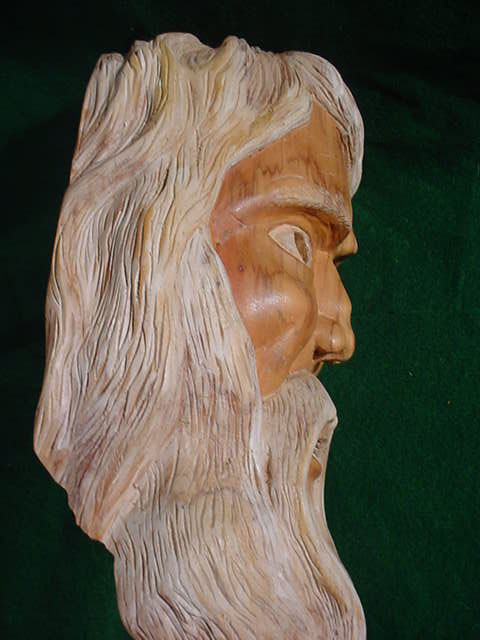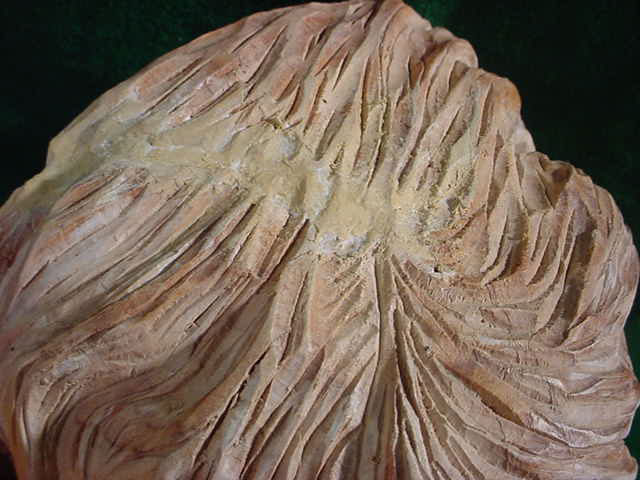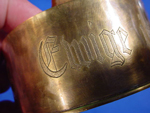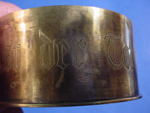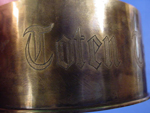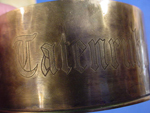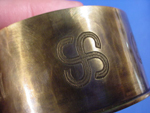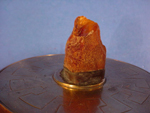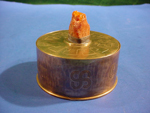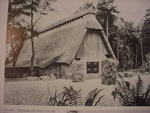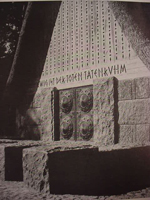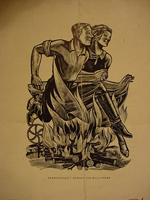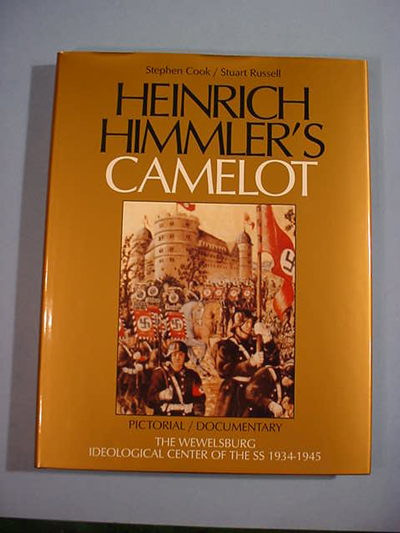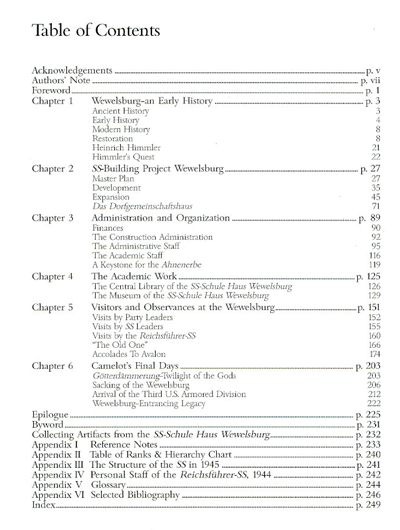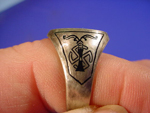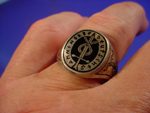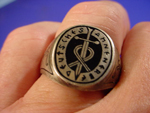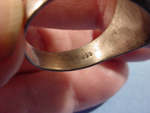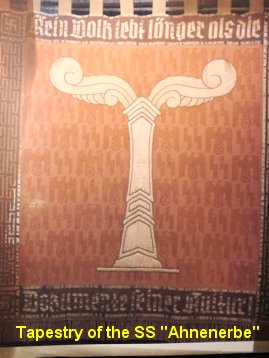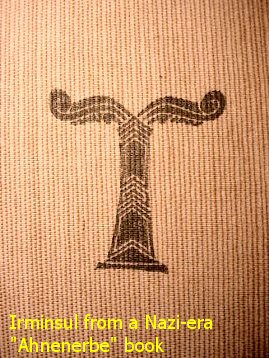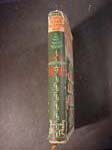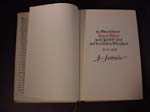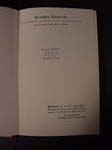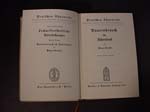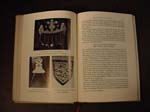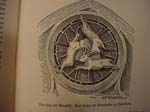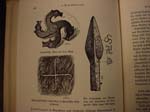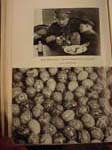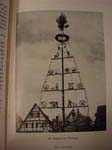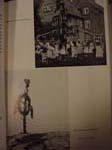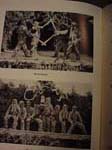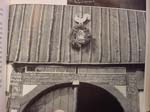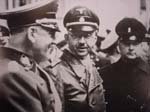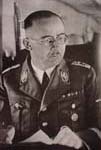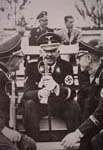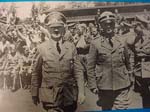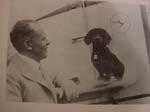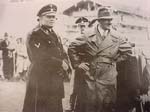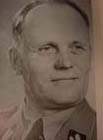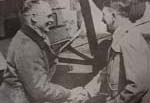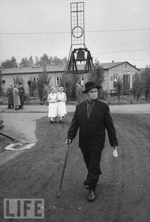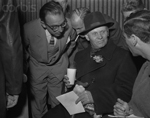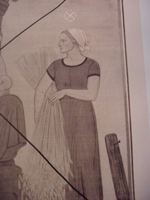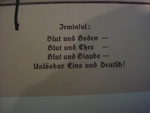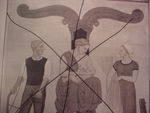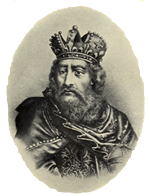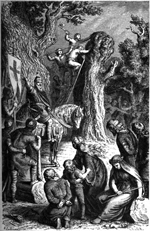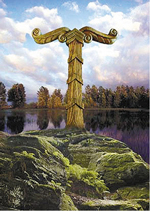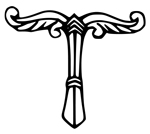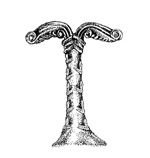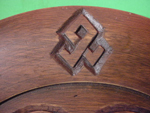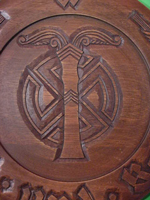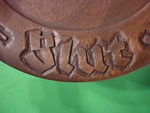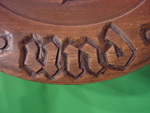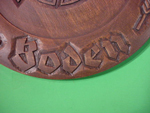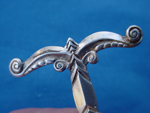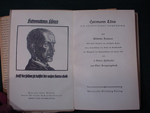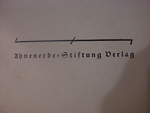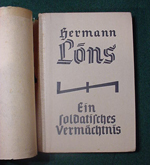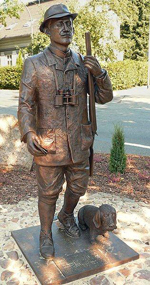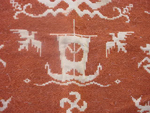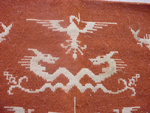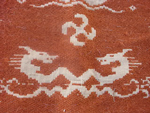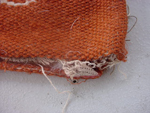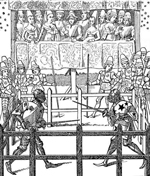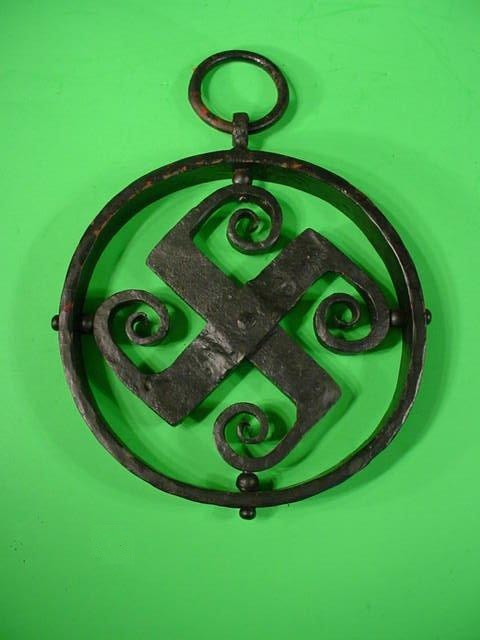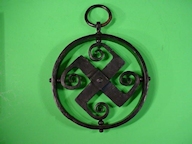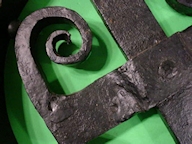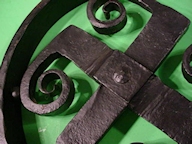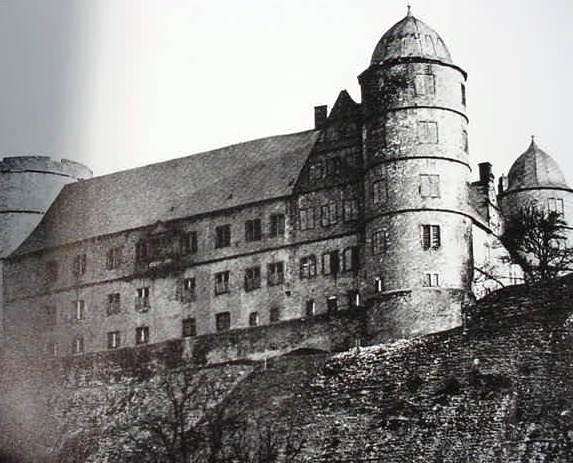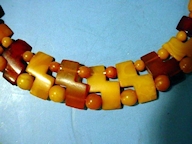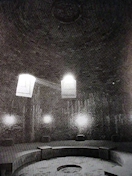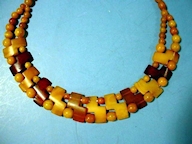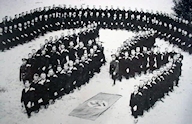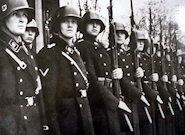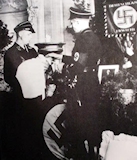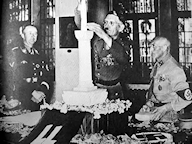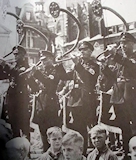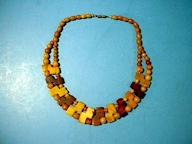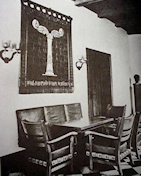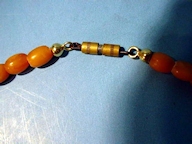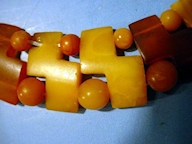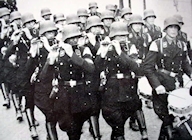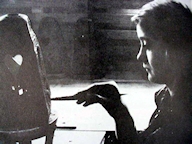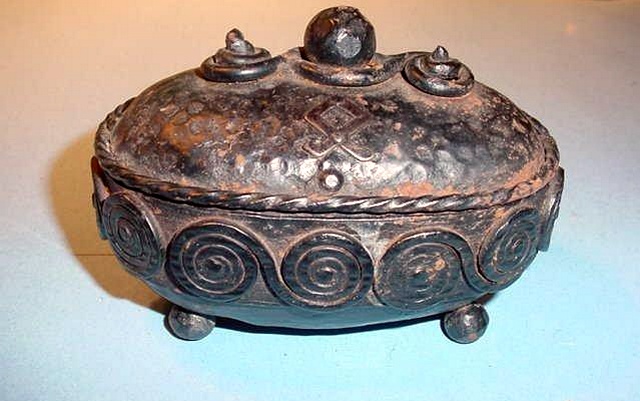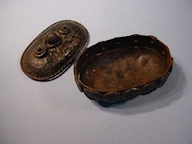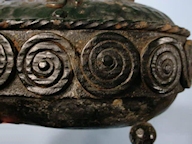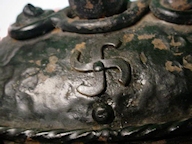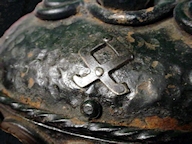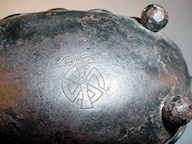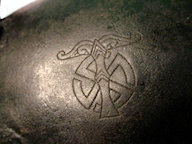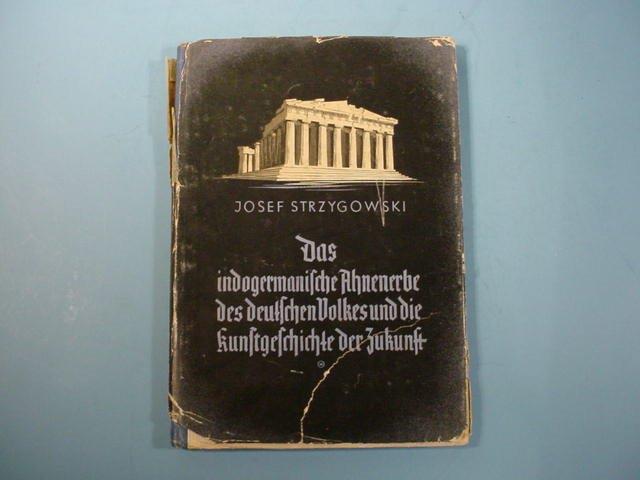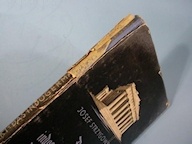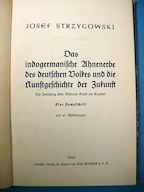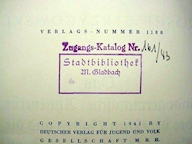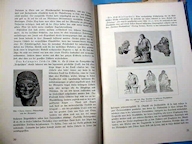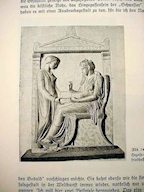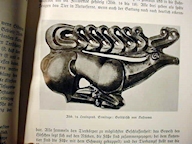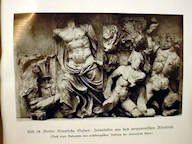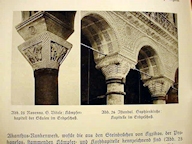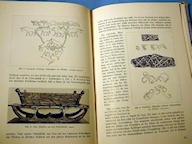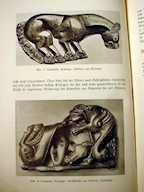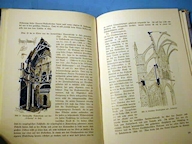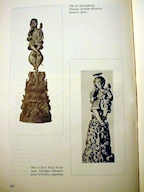|
|
|
|
Deutches Ahnenerbe
Page 4
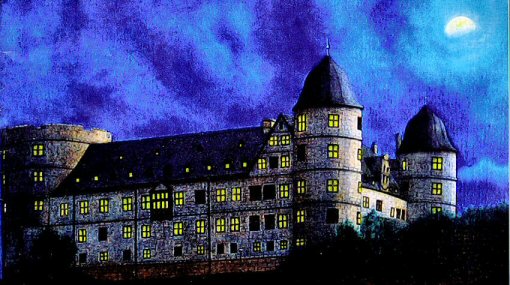 Wewelsberg Castle Venue of various Ahnenerbe ceremonies |
|
||||||||||||||||||||||||||||||||
|
SS-Ahnenerbe Recreation of Ancient Danish Hunting Horn (Item AHN 4-1; VIKING 1-2) |
||||||||||||||||||||||||||||||||
| DESCRIPTION: The SS-Ahnenerbe was composed of 50 departments one of which was a special workshop where certain re-created items were put together using the copies of the ancient tools in their production. These items were distributed to museums throughout Germany. It was admitted that certain ancient items could never be located or bought by these museums, but all the same, they felt it necessary to have re-creations that had the look and feel of the real items. This is one of the extra-special examples of this department’s agenda. The piece is a very accurate museum copy of a Viking hunting horn that was reminiscent of the Golden horns of Gallehus, the famous horns from Scandinavia that were stolen and melted down in 1802. The style of those pieces and the runes upon them would be to the period AD 400-450 and they were crafted in gold. They were of a certain style as known to the warlike Danes (Vikings). They certainly were the sacred national treasure. The more common hunting horns of the Norsemen were crafted from cow horns and were actually used in the hunt by the chieftains and noble warriors, but the design was much like the golden horns and from drawings on rocks, ancient buildings, and Viking ships. The Ahnenerbe artists were able to produce this wonderful replica of a Viking chief’s hunting horn. The carving shows Norse legends, animals, people, half-animal people, and serpents from Aryan saga. Everything had deep meaning to the ancients and to the ancestral heritage foundation itself. The fitting at the far end is sealed shut so that it no longer opens. These horns were not only for the signal, “horrido,” to begin the hunt; they were also used as drinking horns, too. The tip fittings are in brass, while the rim fitting is in silver. Around the edges of the rim are Danish runes that spell out “Deutsches Ahnenerbe.” Our house translator, Wilhelm Reinhard Gehlen, brought this out. Besides reading every type of Germanic script, he also is expert in the language of the runes. This is the greatest Ahnenerbe item we have ever seen or imagined still existed. This is a fantastic find in excellent condition.
PRICE: SOLD |
|
|||||||
|
|||||||
| DESCRIPTION: This is the officer-corps magazine published by the SS printing office and distributed to SS officers. It was strictly a cultural and educational booklet and was always devoted to subjects of the “higher plane.” This was Jahrgang 7 and is a “very special” issue in that it is devoted to the Externestein, the Rocks of the Sun near Detmold. It, of course, has other interesting subjects as well, with great black-and-white pictures. The English phenomenon Stonehenge is also covered, with charts and discussion in the Externestein section, which is also shown (at least in part) on the cover. There is a beautiful picture of the rocks in color plus a great photo of the Sun Alter. This is a fascinating place to visit, but lately the sun chamber had to be sealed off because of graffiti and vandals with pocketknives. I think it would be great to throw a few of them from the heights. I’m sure the ancient Druidic priests would admire me for that, and I would be in ecstasy to accomplish that. Anyway, this is a rare special issue and is certainly worth adding to a fine and important collection.
PRICE: Sold |
|
||||||||||||||
|
Book: Die Krise der Alten Welt
|
||||||||||||||
| DESCRIPTION: Here is the book considered the rarest of them all the works of the Ahneberbe-Stiftung SS ancestral heritage foundation. This is a scholarly work that delves deeply into the culture, art and ruins of the ancient world's own Aryan peoples in Greece, Mesopotamia, the Sahara, an ancient Rome. India and the near East are also explored. There were several Ahnenerbe expeditions to northern India and Tibet to learn more of the origins of the Indo-Germanic races. The book has 259 pages of text and 141 full-page pictures of ancient antiquities. This important book was published under the auspices of the Deutsche Ahnenerbe-Stiftung Verlag, Berlin-Dahlem in 1943 and opens with a quotation from Heinrich Himmler, Reichsführer-SS where he says: “Ein Volk lebt so lange glücklish in gegenwart und zukunst als es sich seiner vergangenheit und der grosse seiner ahnen bewust ist,” roughly translated: “A people, will live longer and be fortunate in the present and the future when the past and the great deeds of their ancestry is cognizant to them.” And, of course, this was the task and agenda of the Ahnenerbe organization to bring about the awareness of the greatness of the Aryan people; das Herrenvolk. This is truly an important book and should be preserved as it was by the library and staff of the SS-Totenkopf Standarte Oberbayern. This was one of the many rare books from this library that were bought in Germany at auction and then found at the Frankfurt Book Fair a few years ago by members of our search team. The book measures 8 x 10 inches and is 1 1/2 inches thick. The condition is near perfect. The inside cover bears the ex libris card of the Totenkopf Library. Seldom does anything this rare show up on the web.
PRICE: Sold |
|
||||||||||
|
Aryan Volk Wood Carving (Item AHN 4-4; ART 14-15) |
||||||||||
| DESCRIPTION: This is a cultural item in the best traditions of the race and resettlement office Rasse und Siedlungshauptamt and that’s where it came from. There was also an Ahnenerbe connection evidently. That is what we were told by the man who sold it to us. It was possibly carved in one of the 50-odd departments within the heritage foundation so an SS connection is entirely plausible especially in light of the inscription under the figures “Unsere Ehre heisst Treue; Unser die Zukunft.” This means: “Our honor is loyalty; and ours the future.” Under this is the national German greeting “Heil Hitler.” This is very similar to the SS motto seen on the blades of their daggers. The only difference being with the word “Unsere” instead of “Meine.” The plaque is carved all out of oak. It measures 10 1/2 x 8 inches. It’s signed with “HO;” whoever that was, he was a master carver. On the back is a penciled ’12 September 1936.’ Was this the date carved or the date presented or both? The portrayal is a young man and young lady who both show the beautiful Nordic, Aryan features as would be expected in an article that was from either of these organizations previously mentioned. We cannot say enough about the carving; look to the hair, the facial structures, the nobility. The wood planchet is about an inch thick. The artist who did this had the “Treue Geist,” the “real spirit.” He has in his depiction of the loyal NS youths transcended the mediocre and mundane and reached the heights of Teutonic splendor graphically illustrating what was to be, but now we have ACDC and KISS. This is almost a spiritual object; observe it as such!
PRICE: SOLD |
|
|||||
|
Rare! Deutschen Christian Bread Plate, 1942 (Item AHN 4-6; NSD 16-6) |
|||||
| DESCRIPTION: This is a real rarity: a bread plate probably for holding the host in the communion ceremony in the Deutsche Christian Church. The church integrated the teaching and doctrine of the traditional Protestant church, Evangelical, and Lutheran, but like Martin Luther, this church stood against the corruption of the inner church’s conceptions. Luther had nailed 99 theses on the cathedral door at Wittenberg and his life afterwards focused on the grace of God and unending disputes with the Vatican. He also saw the Jews as a corrupting influence in true religious piety and the following of Jesus Christ. He felt the Jews failed to heed his warning of eternal damnation and even encouraged congregations to drive them out and burn their synagogues. He called them by the term “synagogues of Satan.” The Deutsche Christian Church integrated and redefined traditional Christianity to include and align with the ideology of the Third Reich, which they saw as a God-sent gift to the German people. The doctrines of the Deutsche Christian Church were meant to replace centuries-old doctrine. Christ was reinterpreted as an Aryan of the highest order; a warrior come to earth to lead his people out of the way of sin that had become their wont. St. Paul was seen as an introverted Jew whose writings Judized Christian thought in an unhealthy way. They believed that that which is weak is inferior and not allowed because Paul teaches in the epistles the putting away of “self.” Paul was seen as having an inferiority complex and this was detrimental to the religious faith of the German people. Concept of the cross and sacrifice are integrated with the concept of “struggle.” They believed that Germans were born to struggle; the battles, earthly and divine, were reinterpreted in terms of “Kulturkampf” The German Christian Church was formed in 1932. They had 600,000 members. This degree of influence enabled them to call in April 1933 for a National Socialist-controlled “Reich Church” to replace the federal statutes of the Evangelical Church; the organization was led by Pastor Ludwig Müller. They supported the movement of the NS Party platform for a positive Christianity. They rallied for the removal of the Jewish Old Testament from the Bible. Their symbol was a traditional Christian cross with a hooked cross (swastika) in the middle and the group’s initials were ‘DC.’ Although it lost much influence after 1939, it still existed to the end of the war and there are committed adherents to it even today. The bread plate is in oak, the holy wood of the Teutonic people. The size is 13 1/2 x 9 1/2 inches. The letters cut around the edges are: “Gib uns Heute Unser [Täeglich] Brot,” “Give us this day, our daily bread.” *The normal spelling of “Daily” in German is “Täglich.” On the plaque we see it spelled “Täeglich,” which is an ancient colloquialism. The center, of course, is carved by hand also and has the cross with sun-wheel swastika and the cross. In addition it has the ‘DC’ for ‘Deutsches Christian’ and the date of 1942. This is possibly one of the rarest and historically important pieces we have ever offered. This is an important and beautiful object of folk art. The letters around the edge are not added; they were actually carved all out of the very same piece of oak. This is the incredible work of a master carver.
PRICE: SOLD |
|
||||||
|
Hand Carved Wooden Mask of Odin from SS in Berechtesgaden (Item AHN 4-6; NSD 16-6) |
||||||
| DESCRIPTION:This is a great traditional mask as used in summer solstice ceremonies held in the various mountainous regions of Germany and Austria. These pictures had theatrical agendas; some were enthusiastically pursued by the N.S. Government. They were demonstrations of Aryan faithfulness and tradition. The huge public dance displays and recreations of ancient “Grove” ceremonies. Continued up to the time of the wars end. The theme was of men believed to personify what they saw as mysticism with the power manifested in “Das Ende”. The Nordic Gods were respected not worshiped but they represented the virtues of Nobility, Self Sacrifice and Virtue; thus Oden, Freya and others were often seen as graven images, especially in the Bavarian and Tyrolean Mountain regions. The SS as an organization was most imbued with the study of the “alte – Germanic” customs and traditions. they often took a major part in these national celebrations. Bear in mind that these were for the most part historical reenactments not deeply religious or occult ceremonies. The persistent idea that the National Socialists were influenced by occult agencies has been dismissed by competent historians as blatent Cryptohistory. The Ahnenerbe or Department of Ancestral Heritage sponsored certain revivals of ancient heritage (including paganism) in the forests and mountains of Germany. Some Ahnenerbe publications show pictures of certain masks such as this one being used in folkish demonstrations and revivals. The various SS and SA groups indigenous to these areas were encouraged to take part in these costumed affairs. Not long ago we encountered a German collector who specialized in SS articles associated with the Ahnenerbe and other cultural aspects of the New Order. He had lived in the Bavaria forest “Bayerischerwald” and at the end of the war he entered a building in Berchtesgaden that a family used as the headquarters of the SS Strum 5/31. Here he was able to procure many books, pictures, letters, ect. from discarded boxes and desk drawers. In a corner above a table was this mask of the God Odin along with some other cloth remnants and a NS Party Flag, plus some other items that were deserted when the last of the SS personal left. The mask is marked with a stamp at the back rim with the words SS Strum 5/31 Berchtesgaden. We were most happy to acquire this from him. The articles that he relinquished were let go because of his age and inability to get around anymore and this convinced him to sell them Here is a SS relic that will take a real knowledgeable Germanophile to understand and desire. We present it proudly as the Web Site for cultural awareness like no other! This is not the ho-hum site as presented by the others out there. We are GERMANIA! This mask is about 14 inches high and about 8 inches across.
PRICE:$1,350.00. A great buy in Teutonic cultural heritage! |
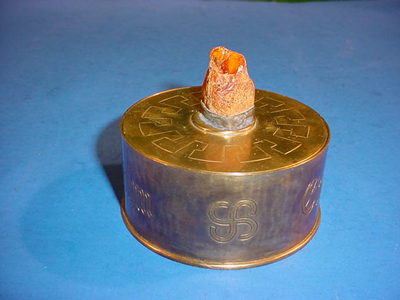 |
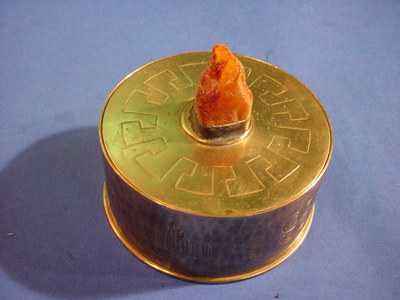 |
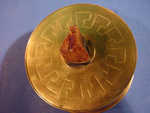 |
| Eternal Flame Bernstein (Amber) (Item AHN 4-7) |
||||
DESCRIPTION: Here is a very special Ahnenerbe piece. We will not go into the history, development and cultural heritage that attaches to the Ahnenerbe or Ancestral heritage foundation, as the person who will be interested in this item will already know those facts. This is for the advanced researcher and collector. Also there is much on the internet about this academic study group. Its meaning is profound and they go deep into the Teutonic and National Socialist mythos and ancient archeology. The brass canister is inscribed with these words “Ewige ist der Toten Tatenruhm” (Eternal are the deeds of the dead). This refers to the fallen of the world war and the martyrs of the early struggle of the National Socialist party but also honors the heroes of the Teutonic past. The lid is hand engraved with an eternal wheel with hooked design all joined. This puts one in mind of the swastika mobile mode. There are swastikas in Sonnenrad form that are found at the beginning and the end of the wording around the surface of the canister. At the center top is a piece of Bernstein (amber) that not only represents the eternal flame but by the choice of this fiery mineral the artists conveys another meaningful message. Bernstein is the national stone or gem of Germany from ages gone by. It has the significance of being the Heilegestein (holy stone) of the Teutonic German Volk (the ancients). No diamond, no ruby, no emerald can compete with its deep meaning to the Teutons or their descendants. Today’s Germans, of course, have lost practically all interest in the glories of the past and to some extent like to self flagellate themselves when dealing with their past. They accept, it seems, the former enemies' tales of horror to be the truth regardless of any proofs that exist to the contrary. However they should look to the utter depravity and abject cruelty that attended such other nation's history, for instance the role of the U.S. Federal North in the American Civil war that unleashed horrors against their brothers in the South in the post war period for no reason other than revenge! Revisionist history today accurately records the horrible terror that they unleashed after the ‘War of Northern Aggression.” Some of us do however give much thought to it and some of us are in awe of a historically important and spiritually valuable treasure such as this memento of the Teutonic mythos. PRICE: SOLD |
||||
|
|
Book: Heinrich Himmler’s Camelot |
|
DESCRIPTION: This is a sensational book that should be a must for any serious SS collector. We felt that it was imperative that we handle it. It is the saga and history of the WewelsburgCastle (also known as “Himmler’s Castle”) from ancient times to the present day, and the roles of the SS, the Ahnenerbe, Heinrich Himmler, Karl Weistor and other personalities. It further explains the surrounding geographic area of Westphalia and its strategic importance to the National Socialist philosophy. Reichsfuhrer SS Heinrich Himmler spearheaded a quest for Germany’s forgotten ancestral heritage and documents of its natural pagan culture. Heinrich Himmler’s Camelot also gives a rare insight as a high quality pictorial of the people, the architectural plans and castle rooms, including the north towers ‘Valhalla’ and “Hall of Pillars” with the “Black Sun” as well as the nearby Externsteine (rocks of the sun) and Hermann's monument (The Battle of Teutons vs. Roman Legions) plus much, much more material to thrill the hearts of true Germanophiles. *
Over 200 B & W photos, plus numerous illustrations and documents all available for the first time in an English language publication. Second hand copies of this hard to find book are sometimes avaiable on the internet for prices of around $120.00 to $195.00 USD. Having been at this castle several times I can say it is a real experience and should not be missed by serious historians. Germania International has a special arrangement with Stephen Cook the author, so the book is available from Germania International, LLC for $108.50 and this price includes postage and insurance in the United States. PRICE: SOLD OUT |
|
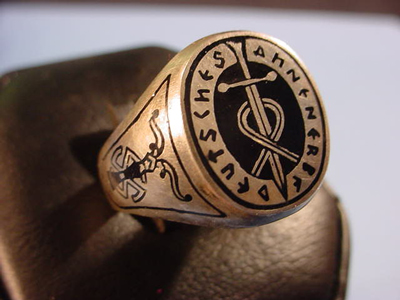 |
Official Ring of the |
|||
DESCRIPTION: This was the finger ring of the Ancestral Heritage Foundation. For a background of this academic study group see AHN 1-1 in this section. This ring like the one mentioned at AHN 1-1 was designed by Dr.Wolfram Sievers who was Reichsgeschaafsfuhrer or General Secretary of the Ahnenerbe from 1935 to 1945. Dr. Sievers was an SS Standartenfuhrer who in 1943 became director of the Wehrwessenshafliche Institute for Military Scientific Research, a separate department of the SS Ahnenerbe, thus receiving his doctorate. The organization was a many faceted entity. The main function was to promote the science of ancient intellectual history. There was a genealogy section, a archeological office, an ancient arts department, a meteorological section, a musicology department whose aim was to determine the “essence of Germanic music", and well known is the expedition department that sent study groups to places like Tibet, the German Island of Rugen, and Backa Sweden. A Middle East trek was launched to study an internal power struggle of the Roman Empire which was fought between the Nordic and Semitic peoples. An entire vast department was devoted to the study of pagan cultures even to the point of studying sorcerers and witches, however it should be pointed out that any connection of the organization or for that matter the Third Reich with occult practices was limited to academic study and in no way did the N.S Government nor the Ahnenerbe research teams indulge in these practices -- that is just pure Hokum! Especially ludicrous is the book by Trevor Ravenscroft “The Spear of Destiny, The Powers of the Holy Lance.” The lance which was the spear of Longinus was actually associated with Christianity not the occult. It was a symbol of faith and fulfillment not an evil entity as Ravenscroft indicates. He also describes Wolfram Sievers as some sort of an evil ‘Warlock.’ Nothing could be further from the truth. The professors of the heritage Foundation were hard working dedicated and brilliant academics who have left positive and great studies to the world. There were at least 50 separate departments of this organization all headquartered in Berlin. The symbol of the Ahnenerbe is a Teutonic sword, whose form also represents a crucifix...the symbol of Christianity. Twisted around it is the ‘Wotan Knot’ signifying the ancient roots of pre-Christian Nordic anthropological beginnings that gave way to the following of Jesus the Nazarene. (“My Savior” !) Around this the words are written in runic shaped letters spelling out- - - - ‘Deutsches Ahnenerbe’ which stands for the actual organizational name which was Forschungs und Lehrgemeinshaft Das Ahnenerbe E.V. (Research and Teaching Community for Ancestral Heritage). This was adopted as the title in 1937. The main mission was to experiment and launch voyages with the interest of proving that prehistoric and mythological Nordic populations once ruled the world! Movies and TV series have spread much misinformation about this intensely significant establishment. When the various items of jewelry were purchased by us at Stuttgart there were a few of these official Ahnenerbe rings as well as others that had been produced. An original order was also found for these pieces and a total of 30 of them were to be produced. However, we found only five. So, it is assumed that either the other 25 were not produced as of that time in 1943 or that twenty five were delivered to the organization; I guess we will never know for sure The rings are what I might call a masterpiece of jewelry design with the sword and knot emblem and Ahnenerbe spelled out. The sides have an image of the sacred Saxon idol (The Irminsul); see page 2 of this section at AHN 2-5 for a brief explanation of the Irminsul that is contained within a description of another ring that we suspect was produced for the SS Ahnenerbe. The rings are constructed in pure 835 silver and are so stamped inside. The enameling was hand applied in Niello style and the original design was by SS Standartenfuhrer Dr.Sievers according to various notes and papers found among shop orders. The work is exemplary and the ring is very handsome in its presentation. But more important is the great academic accomplishments of this meaningful and distinguished group of scientists and professors. The ring is the only symbol of this organization made for everyday wear and reminds us of the outstanding accomplishments in the field of archeology and genealogy forwarded by this Ahnenerbe group. PRICE: $1,200.00 |
|||
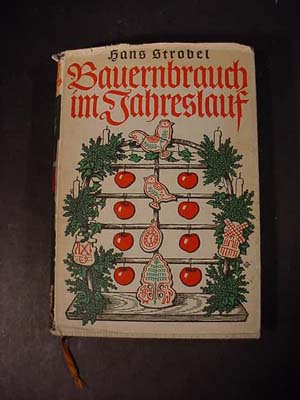 |
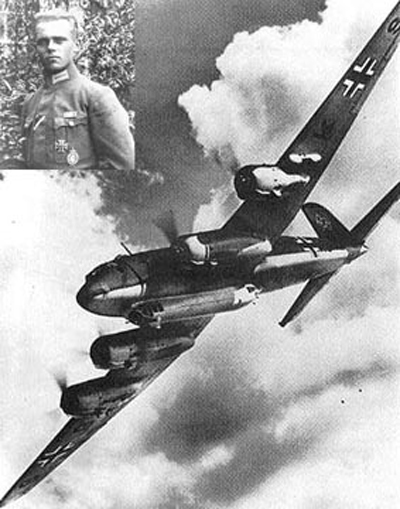 Upper Left: Young WWI pilot, Hans Baur Below: The famed Condor aircraft converted for Hitler and flown by Baur |
Signed Gift Book from Heinrich Himmler |
DESCRIPTION: This is wonderful! An SS Ahnenerbe book presented to the Fuhrer's personal pilot on Julfest 1939. The presentation wording is written in fine calligraphy probably by an Ahnenerbe artist and hand signed by the Reichsfuhrer SS Heinrich Himmler himself. This is a virtual treasure to the SS collector and the collector of Deutsches Ahnenerbe material. The inscription is SS Oberfuhrer Hans Baur zum Julfest 1937 Mit Den Besten Wünchen 22 12 1937 and the signature of the Reichsfuhrer SS to SS Oberfuhrer Hans Baur on Julfest (Christmas Week) 22nd Dec. 1937. An SS Oberfuhrer is equivalent to the Wehrmacht Oberstor (Lt. Colonel). Later, he was promoted to SS Standartenfuhrer (Full Colonel) and in 1944 he was elevated to SS Gruppenfuhrer (Major General). He was Adolf Hitler’s personal pilot and an author, plus SS Police official. He was a highly decorated WWI flyer and leading commercial aviator during the pioneer fledgling days of Lufthansa Airlines in the late twenties. Hitler became the first head of state to use air travel extensively. He personally selected Hans Baur to be the official pilot. “Luftwaffe One” was a reliable four engine condor aircraft which was plushed up and called “Immelmann II” after Max Immelmann a famous WWI pilot who was the creator of the famous dog fighting maneuver used during early combat between planes. Hitler increasingly relied on Baur for advice about air war policy and technical developments. At war’s end, he was trapped in the bunker with his beloved Fuhrer. Prior to being captured by the Russians, he was shot and his injuries were so severe that one of his legs had to be amputated. The Russians were deeply interested in Hans Baur, thinking he had flown Hitler to safety before the fall of Berlin. He endured ten years of tortuous questioning at the hands of Russian agents who finally released him in 1955. He returned to Germany to write his memoirs entitled “Hitler at My Side.” He died in Munich of strictly old age ailments and was interred in the family plot in the Westfridhof in Munich. He was a loyal SS man and even under horrid interrogations by the Reds, he never apologized for his faith and admiration of the Fuhrer. I met him in 1990 and while talking with him I held his little dachshund, Waldi, in my lap. To hear his exploits and look through his albums is a memory I will always cherish. He was a Teutonic Nobleman of the type we have not seen since or is it likely we will ever see again. Now he belongs to the ages! The book would be rare unto itself being one of the scarce books of the “Ahnenerbe” (the Foundation for the study of the Germanic past). You can read more about it in other Ahnenerbe entries on our pages. The book is named “Bauernbrauch Im Jahreslauf” (Customs of the Farmers over the Course of the Past). It is a 207 page text style book on this the occupation considered not only most worthy but particularly sacred by the NSDAP and especially the SS. In this monumental work by a researcher in the Ahnenerbe, Herr Hans Strobel, you will see the customs, and the traditions practiced down through the ages by the farmers covered in depth. Customs that seem strange to us today are shown and explained. Interesting ceremonies are detailed all having to do with pagan beliefs and ceremonies that would hopefully beget necessary good crops and animal harvest. Many of the reenactments seen in photographs were performed by SS Ahnenerbe functionaries. The typical houses in the book demonstrate writing and designs both Christian and Pagan. There are agriculturally inspired songs and poems and writings as well as explanations of the local customs of Bauern in all the German land – colorful maypoles, the flaming wheels, and the cultural importance of the pretzel and of oak trees is explained. Ancient talismans are studied; the Christmas and Yuletide legends are delved into in detail. Many ancient, important wood and stone carvings are illustrated in drawings. The Ahnenerbe researcher left no stone unturned while creating such a handbook dedicated to German agriculture and its honorable history. This aspect of the studies of the ancestry institute was the passion of Heinrich Himmler, SS Reichsfuhrer, and he personally indulged himself in it to a great degree. It seems quite natural in our estimation that he would choose copies of this book. For his personal choice of Julfest gifts to his closest friends and certainly Hans Baur would definitely be one of his very closest. The SS motto that was “Meine Ehre Heist Treue” (My Honor is Loyalty) was ever present in the mind of General der Luftwaffe and pilot extraordinaire, Hans Baur. The book measures 6 ½" x 9" and is a little over 1 inch thick. It has the original colorful dust cover and bears the personal stamp inside from Hans Baur Flugkapitan and Colonel of Police in Stefeld Oberbayern. On the forward leaf is a statement from Himmler that roughly translates to “A people will live so long in happiness in the present and in the future if they are conscious and aware of their past.” Very appropriate for this important volume I’d say! So, here we have a virtual 3rd Reich treasure and it’s not a field pack, nor a steel helmet, it is not a hand grenade or even a Knights Cross. No, it is my personal belief that this little book surpasses all the above in importance but perhaps I am prejudiced or just maybe historically knowledgeable and motivated in the way that I think. To me, this may be one of the most historically great relics we at Germania have ever offered. PRICE: SOLD |
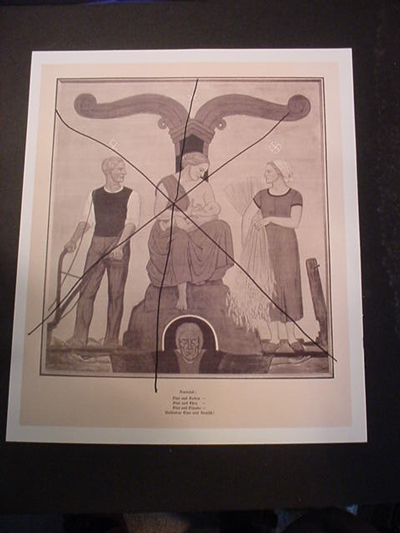 |
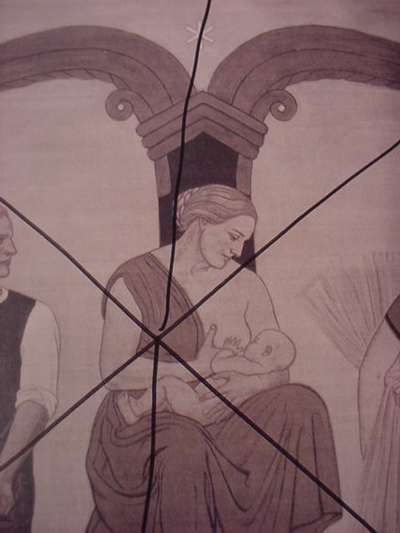 |
Picture of the Irminsul “The Spirit of the Saxon Mythos" Envisioned in the Third Reich (Item AHN 4-12) |
DESCRIPTION: Here is a very framable print of a Third Reich depiction of the sacred Irminsul -- the meaning in ancient Saxon language is probably Great mighty pillar or Arising Pillar. It played a prodigiously important role in Germanic paganism. The oldest chronicle describing an Irminsul refers to it as a tree trunk erected in the open air. The purpose of the Irminsul’s and the implications thereof have been the subject of considerable scholarly discourse and speculation for hundreds of years. The Germanic God Irmin inferred by the name Irminsul and the tribal name “Irminones” is sometimes presumed to have been the National God of the Saxons. It has often conjectured that the Irminsul was a “World Tree” the equivalent of Yggdrasil among the Saxon tribes of Germany, likewise it is unknown whether the venerated piece was made of wood or stone or whether there was one or several? Meanwhile the "T" shape Irminsul representation seen today is rather conjectural. The SS Ahnenerbe or office of ancestral heritage envisioned it in that particular depiction, a tree like column stretching its arms outward toward the world of Nordic, Aryan, peoples and their racial kin. According to history and legend the Irminsul was situated at or near the Externsteine the famous rock formation near Detmold, Germany. A Christian relief on the Externsteine depicts what is described as a bent Irminsul design under the feet of Nicodemus who lifts Christ from the Cross. This art work variously dated to the early ninth to early 12th century AD is believed to represent the bent or fallen Irminsul beneath triumphant Christianity! In the 1929 interpretation of archaeologist Prof. Wilhelm Teudt the researcher connected the theories of Goethe who discussed the relief carving in detail and his own studies. Teudt was a member of the SS Ahnenerbe and this academic organization of the SS undertook in 1934 and 1935 extensive fieldwork in uncovering material evidence that the Externsteine was a place of Germanic pagan worship. Note in our pictures that the feet of Nicodemus are missing as they would be in the depiction of the crucifixion are missing. Could it be that centuries ago some Saxon faithful to his religion came and hacked the offending limbs off the depiction of Nicodemis due to what he saw as blatant irreverence for this sacred symbol of his faith? The NSDAP in general and especially the SS considered these stone formations sacred as this in their considered estimation was truly the site of the sacred Irminsul venerated by the Saxons in 772. At the beginning of his bloody campaign against the Saxons it is known that Charlemagne (Karl Der Grosse) destroyed the gigantic pillar that stood at the top of the high natural and living stone column. This was the tallest rock in the Teutoberg Forest where Hermann the Cherusci leader led his Germans in a brilliantly staged attack that destroyed three of Rome’s best legions in 9 CE. This Irminsul was of course the symbol of the Saxon people and the great murderer knew this would be the destruction of the soul of the Saxons. The Externsteine stood as the beacon of the heathen world, the most Holy stead, certainly of the Northern tradition, yesterday and even to some of the faithful even today. The National Socialists thought it represented a resurgence of Germanic tradition and intense pride of ancestry. Many ceremonies presented by this scholarly group were held at this spiritual place. It was also a place of reverence. For the memory of almost 5,000 Saxon chieftains who Charlemagne murdered by the most foul of means thereby finally subjecting the survivors to baptism and Christianity. An Indian woman who was known to the Germanophile world as Savitri Devi Mukherjii in her prodigiously interesting book (Pilgrimage) had much to say about her visit soon after the War to this sacred area; she says much about the Externstiene and the Irminsul .On page 347 she observes “Within an hour or so” thought I “I shall be greeting the rising sun from the ancient high place over which the Golden Irminsul used to glitter in far gone times; over which the swastika flag still used to flutter...I shall be greeting the rising sun… and sealing my life’s dream with the seal of eternity!” The print or poster that we offer is a copy done on heavy cardboard stock of the first order. It is done expertly in the same sepia tones as the original that is in my own collection. The depiction here is the Sacred Life Tree rising like the Phoenix with symbols of the Odel rune meaning home or homestead, inherited characteristics family bond. Then just above the Irminsul’s middle top is the Hagel rune which means “I destroy or I protect” (preservation of the race in both instances). To the right as you view it is the “Sonnenrad” or Sun Wheel. This runic symbol represents Eternity and continuation as the rays of the life giving sun turns in endless time. All of the above are then personified with the human figures as necessary agriculture is depicted by the noble looking Aryan man with the plow who stands ready to labor with his soul mate and wife as she is depicted in true Nordic beauty with the “wheat of life” in her arms. The central theme is the depiction of the birth mother as she fulfills the duty of motherhood and she nurtures the babe the future of our race. Below all of the above is the somber figure of a prophet of old who holds the destiny of the world in his hands. Below this figure are the words that translate to: Blood and Soil The poster measures 15 ½ x 13 with a white border left to facilitate farming. The picture we show is compromised with black lines through it -- why? Because many unscrupulous persons, some with anti-bewegung and liberal notions have copied pictures from our site without authorization in the past and we don’t like it! Many of the items we offer are for the enjoyment and edification of fellow Germanophiles and often in the end we do not even make money at it. When all is considered we feel that bringing this wonderful copy of an important Third Reich photo document such as this is really a labor of love. Believe me we could frame these and sell them at three times the price we ask in several auctions but we want to see a wide distribution of this “Kulturstuck” and thus we ask only: PRICE: $45.00 each or two for $75.00. |
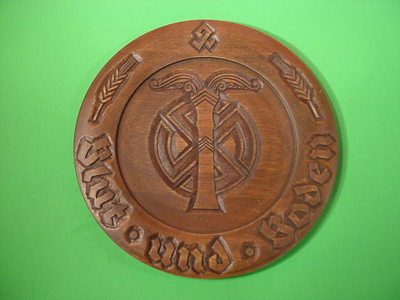 |
Irminsul Bread Plate “Blut und Boden” (Item AHN 4-13 & BRE 1-4) |
DESCRIPTION: This is a typical Germanic bread plate but its message places it in the ‘rare’ category. It depicts the Irminsul of the SS Ahnenerbe or Ancestral Heritage Foundation. At its top you see the Odel rune and at the sides are the words ‘Blut und Boden (translation: Blood and Soil), while at the sides are wheat sheaths to signify bread (the staff of life). The Irminsul is backed up with the ancient sun symbol, the ‘Sonnenrad’ or Sun Swastika. The plate measures a little over 11 inches in diameter and of course is hand carved. Those of you familiar with the Ahnenerbe and some of the mythos of the National Socialist ideology will know about the important symbolism of the Saxon Irminsul. For further information on that sacred symbol, type in Saxon Irminsul on Google; for fascinating information found there. This bread plate is the personification of what is termed Teutonic legend that is indeed as fascinating as the quest of the Holy Grail! Who but Germania could offer something as awe inspiring and wondrous as this? PRICE: SOLD |
 Obverse View |
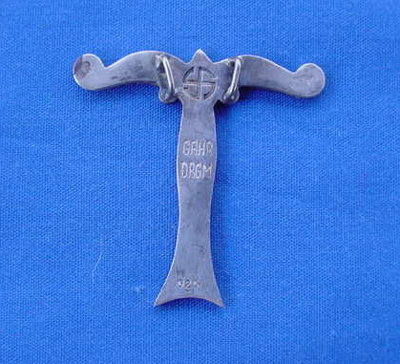 Reverse View |
 Irminsul Pendant by Franz Schnell & Sohn (Item AHN 4-15) Irminsul Pendant by Franz Schnell & Sohn (Item AHN 4-15) |
DESCRIPTION: This is a piece of fine jewelry from the workbench of Germany’s prestigious silversmith Herr Franz Schnell who worked in Halle am Salle in the Eastern region of Germany. He enjoyed the privilege of having several of the National Socialist inner organizations as customers. Himmler, Goring, Goebbels all had articles designed and produced by this outstanding artisan. He also had exclusive contracts with several of these groups; he was the only jeweler who was contracted by the SS Ahnenerbe, the Ancestral Heritage Foundation, and Wolfram Sievers (Reichgeschaftsfuhrer) or managing Director of the Ahnenerbe. This famed SS Standartenfuhrer was quite enamored with Schnell’s silver mastery and although the staff members of the Ahnenerbe had no uniform distinguishable as such they did have rings and other jewelry that distinguished them from other organizations within the Algemeine SS. We have shown at least three rings designed by Schnell for Sievers and the Ancestral Heritage Foundation. Female workers would be entitled to wear a pin or pendant that would be a symbol that indicated their membership but also their interest in the Teutonic past and its glories. The Irminsul that I have explained on this page (Item 4-12) was probably the item most depicted in the academic papers and documents of the organization and it was the symbol used most often in the jewelry utilized by the foundation. This pendant was designed to be sold possibly by other companies that Schnell worked with, such as Otto Gahr of Munich. The design is exquisite. A true representative totem that bespeaks ‘Heil Teutonia”! The design is delicate but strong. The obverse side is artistically perfect in its whole visage with the stylized tree trunk and sweeping branches. The back is designed with two ‘jump rings’ fashioned in such a way as to always keep the obverse from turning over when being worn. Between the jump rings is the symbol of the Sonnenrad Hakenkreuz or Sunwheel Swastika. This symbol to the ancient Teutons was at least as sacred to Germanics of the Third Reich as the Irminsul itself. It is assumed that Reichs Geschaffsfuhrer Sievers would have wanted this sacred symbol to be incorporated into this salient, highly significant trophy of Aryan pride. Below this you can see the name Gahr and D.R.G.M. The Gahr name is on the piece because Schnell was producing the Irminsul from an original concept by the famed Otto Gahr of Munich -- this man was the jeweler who produced the Totenkopf Honor Rings of the SS, also the official SS cufflinks and many other pieces of official jewelry for the SS. Gahr did not actually produce this piece. It was definitely crafted in the shop of Franz Schnell of Halle. But there was a close business relationship between Gahr and Schnell and they worked together in various projects and evidently including this one. We can only assume that this piece was the result of a joint effort since these examples were found by Schnell’s son on his workbench. We don’t know if the pieces were ever sold or issued by the SS Ahnenerbe. We do point out that they were found in a small tin tray type box that was marked Ahnenerbe and W. Sievers. We also point out the letters D.R.G.M. This is a registered mark that provides an initial three years patent protection to the applicant. Since this Irminsul was produced by Schnell, designed by Gahr and was meant to be on insignia of a major N.S. organization, obviously a patent was applied for. D.R.G.M. signifies ‘Deutsche Reich Gebrauchmuster.” At the bottom of the Irminsul trunk is the 800 mark that is the silver content proof. The height of the piece is 1 ¼ inches and has roughly the same measurement across the spread arms. This is literally a gem of Third Reich jewelry. If you read our narrative found on our Home Page entitled ‘About Our Rings and Silver Insignia” you will learn about the fascinating scenario of how we managed to find and purchase this immense treasure trove. We have three of these beautiful silver pieces here but our German colleagues have two of them struck in gold that were found at the same time. Obviously the Ahnenerbe was the only SS organization that was allowed to wear something made in gold, and that because of the obvious connection to Germanic antiquity. The ancients revered gold as the metal of the sun. The metal sacred to Teutonic myth and Saga. However, Heinrich Himmler disdained the precious metal because he considered it to be the mark of Jewish merchandising and world power. So it is supposed that this exception was allowed by the SS Reichsfuhrer. So here we have a link to the Teutonic past and a meaningful example of the artistic and historical conviction of the third Reich. PRICE: ALL SOLD |
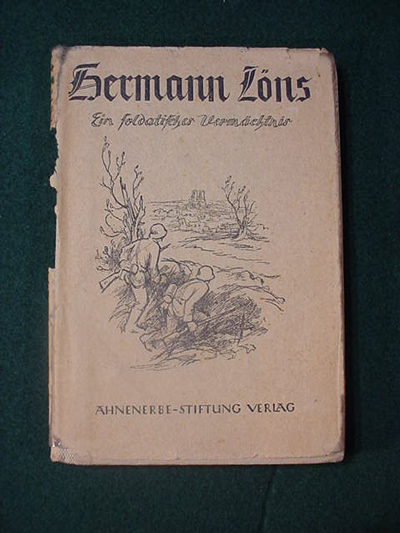 |
Ahnenerbe Book on Hermann Lons (Item AHN 4-16) |
DESCRIPTION: Hermann Lons (1886-1904) was a German Journalist and writer. He is most famous and known as the "Rock of the Heath" for his novels and poems celebrating the people and landscape of the North German Moors, particularly the Luneburg Heath in Lower Saxony. Lons is well known in Germany for his famous folksongs. He was also a hunter, natural historian and conservationist. He wrote several short stories and novels, inspired by pre- and post-Christian folklore and history. His most famous novel was “Der Wehrwolf.” At the age of 48 he volunteered for service in the German army in WWI and unfortunately for him and the whole literary world, he was slain on the battlefield on Sept 26, 1914 while on patrol at Loiver, France only three weeks after entering the service. Because many of his writings showed nationalistic ideas he was later considered by the National Socialists as one of the writers who best exemplified noble Germanic themes for the Age. His ideas and works did fit ideally with the Blood and Soil ethos of the N.S. regime and several N.S. ideologues such as Walter Darre and Alfred Rosenberg lauding the peasantry and small rural communities as the life blood of the German Nation. So most naturally this man and his wonderful concepts were noticed by the PRICE: $216.00 |
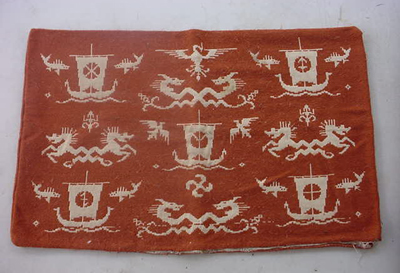 |
Pillowcase Reminiscent of the Tales and Sagas of Teutonic Legend (Item AHN 4-18) |
DESCRIPTION: This is a great find for the dyed in the wool Germanophile who also can appreciate Nordic aesthetics. It is pillow case that measures 27 x 18 finished both sides. It appears to be hand woven and is in good shape except for some fraying at the right bottom corner. It depicts the ancient tales of the sea with a Viking style ship, eagles in flight, sea dragons, whales and Sonnenrad Hakenkreuz (sun wheel swastika). It is typical of the SS Ahnenerbe work from one of their 50 departments where they recreated items of antiquity for children’s history lessons. After all they were the foundation for the preservation of Germanic heritage and a credit to the genius of Reichsfuhrer SS Heinrich Himmler who, along with Professor Wilhelm Teudt, founded it. Academia owes much to this N.S. organization for their projects and studies. That will come out in a century or so and the group will be praised instead of being demonized as is presently the case. PRICE: SOLD |
 |
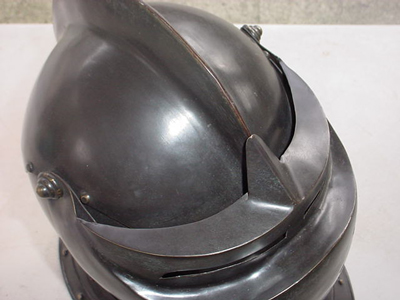 |
Close Helmet (SS Ahnenerbe Museum Recreation) (Item AHN 4-19 & OLD 7-8) |
DESCRIPTION: The Close Helmet was originally a military helmet worn by Knights and other combatants during the late Medieval and early Renaissance era; it carried a visor that pivoted up and fully enclosed the head and neck area. Unlike other helms which sometimes may have left the wearer more exposed, the Close Helmet was used in battle but was also popular in tournaments. The Order of the Knight Templar and the Teutonic Knights adopted the Close Helmet as one of the basic pieces of combat armor. The one we offer is on heavy gauge steel and is the classic type. It is not from Medieval Times. It, in fact, is a copy but an accurate copy, produced in the workshop maintained be the Deutsches Ahnenerbe Stiftung which was the ancestral heritage foundation. This was a section of the SS organization that we have described in other narratives in this section of our site and the purpose of this helmet being accurately recreated was for museum display and as a teaching aid; this is not the modern junk made in India (far superior!). We let our pictures do this, for there is nothing much more we can say about this beautiful exhibition piece. It would make a great den decoration; this is true but its importance as a relic of the aesthetic involvement of the N. S. party and the SS in such important historical recreation and reenactment cannot be dismissed. In generally all over condition the helmet is practically immaculate and it came from a long time established collection that went to auction years ago. The collection was in fact in a German castle but due to the ravages of an unnecessary horrid war, the helmet was frankly looted by the “Liberators” and then found its way into the collection of a wealthy gentleman but when this original owner passed on, the display was broken up by the heirs who sent several items to auction. The piece was probably manufactured using old methods of metal work somewhere in the 1940s; the helmet is the closest to authentic that a collector might hope for without spending multiple thousands of pounds or dollars and its obvious importance to the history of the SS cannot be overlooked. PRICE: $1,850.00 |
|
|
Iron Swastika (Item AHN 4-20; NSDAP 18-37) |
DESCRIPTION: The Third Reich could be called the “Iron Reich.” Many items meaningful to the Germanic Teutonic mythos were made of iron. This metal has been smelted from as far back as 1500 BC to the ancients. It was more important than gold. It was from iron that weapons of warfare and hunting were forged. Later armor was fashioned from this metal. The discovery of it and its applications became almost sacred to the ancient Germanic tribes and then to the Middle Ages when cannons ruled the field of war. Of the seven metals known as the metals of antiquity, gold, silver, copper, and iron were king! These items, especially iron, were the metals that civilization was based upon. Think about the words that have come out of the past concerning iron. Governments speak of iron rule! Bismarck was the Iron Chancelor, Germany’s medal of valor was the Iron Cross. This was commonly called in ancient times “the warriors’ metal” and it was thought to be sent from and ruled by Mars. Iron was and is used in rituals and amulets made of iron-promoted energy, strength, determination, willpower, assertiveness, and aggression. We even advise that humans would eat of that which contains iron for maximum health. So this metal is still king. The National Socialists were aware of this and they celebrated it in books, plays, art and, of course, architecture. The metal was venerated ceremoniously and the ancient wisdom was celebrated in not only jewelry, but in symbolic décor that was seen on display all through the Reich. It was so used by the SS, the SA, and in rituals of the NSDAP and especially by inner cultural groups such as the Deutsches Ahnenerbe Stiftung, where artistic configurations such as the one we offer here were re-created from ancient themes. Often, farmsteads would have such a talisman hanging above their doors as a sign of kinship and welcome. This particular piece is in the shape of a Hackenkreuz (swastika). We know that this symbol was used by dozens of ancient culture groups worldwide, but here we are only interested in the Teutonic Germanic usage long before the adoption of the Hackenkreuz by the National Socialists. It was used in the Germanic lands going back into the earliest times. To the peoples of classic antiquity it was a symbol of eternal light from the sun and its arms represented the movement of the solar orb. It was often seen on the war shields of the Aryan tribes. In the 20’s and 30’s the symbol was incorporated into the flag of Nazi Germany. The form of this swastika was called the Sonnenrad: the sun-wheel Hackenkreuz. Unlike the stationary figure most used in the N.S. flags this depiction was mobile and perceived as moving. This one was said to have been blacksmith made for the SS-Ahnenerbe (The foundation for historical research), Reichsführer Himmler’s favorite department of the  organization. Many re-creations of ancient symbolism were turned out by this academic study and exploration institute. These were a reminder of the glories of Germany’s colorful past. The piece is in solid iron and measures 8 ½ inches in diameter and the smaller suspension ring is 3 inches in diameter. The piece is quite thick and heavy. This is a great relic of the cultural Reich: “Kein Volk lebt länger als die Dokumente seiner Kultur!" organization. Many re-creations of ancient symbolism were turned out by this academic study and exploration institute. These were a reminder of the glories of Germany’s colorful past. The piece is in solid iron and measures 8 ½ inches in diameter and the smaller suspension ring is 3 inches in diameter. The piece is quite thick and heavy. This is a great relic of the cultural Reich: “Kein Volk lebt länger als die Dokumente seiner Kultur!"
PRICE: SOLD |
|
|
|
Amber Necklace from the |
DESCRIPTION: Here is an absolutely wonderful necklace made completely from Prussian Bernstein (amber). Look closely at the associated images and you will see that the main planchets are shaped like victory runes ( ). This is the typical type of thing that was produced in one of the departments of the ). This is the typical type of thing that was produced in one of the departments of the  -Ahnenerbe, the Ancestral Heritage Foundation. We will not go into an explanation of the functions or history of this learned group of historians and early revisionists because if you read any or all of the narratives about the Ahnenerbe Stifftung you will know that this was a foundation set up by the Reichführer-SS Heinrich Himmler in 1935, and was an Ancestral Heritage Research and Teaching Society or Ahnenerbe Forschungs und Lehrgemeinschaft. Much can be learned by going into Google and typing in “Ahnenerbe SS,” and by reading our narratives on the previous pages of this section. Under the teaching aspects of this academically refined organization there was a section that reproduced or re-created various articles from the Aryan Germanic past. Especially researched were the connections made that chronicled the early Germanic use of the swastika and other runic symbols such as the (S) rune that we know became the symbol of the -Ahnenerbe, the Ancestral Heritage Foundation. We will not go into an explanation of the functions or history of this learned group of historians and early revisionists because if you read any or all of the narratives about the Ahnenerbe Stifftung you will know that this was a foundation set up by the Reichführer-SS Heinrich Himmler in 1935, and was an Ancestral Heritage Research and Teaching Society or Ahnenerbe Forschungs und Lehrgemeinschaft. Much can be learned by going into Google and typing in “Ahnenerbe SS,” and by reading our narratives on the previous pages of this section. Under the teaching aspects of this academically refined organization there was a section that reproduced or re-created various articles from the Aryan Germanic past. Especially researched were the connections made that chronicled the early Germanic use of the swastika and other runic symbols such as the (S) rune that we know became the symbol of the  where two of these configurations were seen side by side. In this necklace we see six groups of amber planchets that are shaped as where two of these configurations were seen side by side. In this necklace we see six groups of amber planchets that are shaped as  runics as used by the “Black Corps.” Since the Ahnenerbe was a branch of the Allgemeine- runics as used by the “Black Corps.” Since the Ahnenerbe was a branch of the Allgemeine- this was particularly meaningful to the foundation. Amber had very special meaning to the N.S. mythos as did the oak tree that was also sacred to the ancient and modern Germans. Amber was thought to have mystical powers and the wearing of Bernstein was conducive to health; both physical and mental. Amber or Heilege Bernstein was used in various ceremonies and ceremonial objects of the SS. The Reichsfüherschule (Reich’s Leadership School of the SS) used objects crafted in amber for displays and instruction in Aryan values and perceptions. It truly was to the Teutons the Holy Stone (even though it is not a stone in the usual sense of the word). It’s actually resin, or tree sap, that is millions of years old. Over the many centuries this material fossilized from the ancient trees and formed through a natural polymerization a hard formation with a beautiful, soft, cream hue in colorization. We have visited the story of amber in other places on our site. We have also explained the reverence that was given to it by the Teutonic people through the ages. The ancient Romans believed that amber protects one from evil forces and heals from illness. The Germanics believed that it protected from all sorts of evil spells. They considered jewelry crafted from it would often be an antidemonic amulet or necklace like this one we offer. It was also believed that amber beads hidden in a baby’s clothes would counteract any malicious forces. Bernstein was always a symbol of truth and integrity and its soft, but strong visage is pleasing to the person viewing it and fills them with admiration and awe. That is precisely why the occasional Mein Kampf book by Adolf Hitler is found with a cover fashioned from amber. See the one we obtained and feature at AH 26-26. Also, see the "Presentation Bernstein Box" presented to SS-Obergruppenführer, Hans Adolf Prutzmann, at SS 35-8. This necklace is about 14 inches long and the fittings for fastening it together have been replaced. The original was quite worn and did not any longer have closures effective enough; the new one is exactly like the old. Among SS-Ahnenerbe articles and general this was particularly meaningful to the foundation. Amber had very special meaning to the N.S. mythos as did the oak tree that was also sacred to the ancient and modern Germans. Amber was thought to have mystical powers and the wearing of Bernstein was conducive to health; both physical and mental. Amber or Heilege Bernstein was used in various ceremonies and ceremonial objects of the SS. The Reichsfüherschule (Reich’s Leadership School of the SS) used objects crafted in amber for displays and instruction in Aryan values and perceptions. It truly was to the Teutons the Holy Stone (even though it is not a stone in the usual sense of the word). It’s actually resin, or tree sap, that is millions of years old. Over the many centuries this material fossilized from the ancient trees and formed through a natural polymerization a hard formation with a beautiful, soft, cream hue in colorization. We have visited the story of amber in other places on our site. We have also explained the reverence that was given to it by the Teutonic people through the ages. The ancient Romans believed that amber protects one from evil forces and heals from illness. The Germanics believed that it protected from all sorts of evil spells. They considered jewelry crafted from it would often be an antidemonic amulet or necklace like this one we offer. It was also believed that amber beads hidden in a baby’s clothes would counteract any malicious forces. Bernstein was always a symbol of truth and integrity and its soft, but strong visage is pleasing to the person viewing it and fills them with admiration and awe. That is precisely why the occasional Mein Kampf book by Adolf Hitler is found with a cover fashioned from amber. See the one we obtained and feature at AH 26-26. Also, see the "Presentation Bernstein Box" presented to SS-Obergruppenführer, Hans Adolf Prutzmann, at SS 35-8. This necklace is about 14 inches long and the fittings for fastening it together have been replaced. The original was quite worn and did not any longer have closures effective enough; the new one is exactly like the old. Among SS-Ahnenerbe articles and general  items, this has to be one of the most exotic and rare items we have practically ever offered or seen. This is for the advanced collector and historian. items, this has to be one of the most exotic and rare items we have practically ever offered or seen. This is for the advanced collector and historian.
PRICE: SOLD |
|
|
Iron Box from the |
|
DESCRIPTION: This is a typical Ahnenerbe item that reminds one of the ancient Teutonic past. One of the multiple departments of this ancestral heritage foundation was concerned with producing accurate re-creations of ancient Germanic items for purposes of display and education. This container or box would have been representative of the Iron Age. The Iron Age, ushered into the world with the clank and clatter of the blacksmith’s anvil, is the period in European history that dates from about 800 BC to the Roman conquest when iron was first used instead of bronze to make tools and weapons. In the parts of Europe that the Romans never quite conquered, including Germany, the term Iron Age is used to cover the time up to the Medieval period.
Iron Age people are sometimes referred to as Celts, but other groups are also known from Europe at this time as Germanics. The latter were known to have made highly decorated metal objects which we call Teutonic or Germanic. These objects, like the casket, were often skillfully made and the techniques used to make them were technologically advanced. We do not have any knowledge of the purpose of this item in antiquity, but it is perhaps a logical assumption that it was used as a container of some type and whether it was used for jewelry or sacred religious objects can only be a subject of conjecture. We do know; however, that this re-creation of it was of Ahnenerbe manufacture. On its bottom is the symbol of the Irminsul with Hakenkreuz (Swastika). This was the logo of the SS-Ahnenerbe. On the lid of the piece you can see the swastika in the Sonnenrad configuration (sun symbol) and the Odel rune, this was the Nordic runic symbol that signified property or inheritance, wealth and prosperity. Could this be a key to the purpose of the box? The item measures 5 inches long; 3 ½ inches wide and 3 ¼ inches deep not counting the feet.
It is extremely rare in the fact that SS-Ahnenerbe relics very seldom show up and when they do Germania International goes to great length to procure them. If you want to know more about this special, heritage foundation read about other Ahnenerbe pieces in this section of the site. This is a museum piece representing one of the most learned institutes of historical knowledge that the world ever knew or will ever likely know.
PRICE: SOLD |
|
|
Book Das indogermanischen Ahnenerbe des deutschen Volkes und die Kunstgeschichte der Zukunst (Item AHN 4-23) |
|
DESCRIPTION: Written by Josef Strzygowski in 1941, this is a 144-page study of ancient cultures. Its name translates to The Indo-Germanic Ancestral Beginning of the Germanic People and Artistic History for the Future. We have explained much about the Deutsches Ahnenerbe in other narratives in these pages and this book is similar in scope. It shows in complete text and 47 crisp, clear pictures many of the art masterpieces of the world—mostly centered on Germanic beginnings. It is a prodigiously scholarly work as all Ahnenerbe publications are, so much so that the director of the institute, Wolfram Sievers, was murdered at the end of the war by vengeful ‘victors’ and their loathsome handlers. The dastardly act brought conclusion to one of the greatest academic research projects the world has ever seen. The book is measures t 10 x 7 inches. The dustcover is a bit tattered, but the book itself is in very good condition with some slight staining on the inside linen cover. For the true researcher and historian this book is a truly rare find.
PRICE: $175.00 |
Page Four |
Please refer to item designator in parentheses in all correspondence.
Please E-mail for any additional information you may need.If you prefer, contact 'Germania' at PO Box 68, Lakemont, GA 30552
or call at 706.782.1668.
Please! do not call during the wee hours of the morning. The best time for calling us is between 10am and 12 noon and between 9 and 11 pm eastern time.


